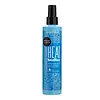What's inside
What's inside
 Key Ingredients
Key Ingredients

 Benefits
Benefits

 Concerns
Concerns

 Ingredients Side-by-side
Ingredients Side-by-side

Water
Skin ConditioningAlcohol Denat.
AntimicrobialCrotonic Acid/Vinyl C8-12 Isoalkyl Esters/Va/Bis-Vinyldimethicone Crosspolymer
Octylacrylamide/Acrylates/Butylaminoethyl Methacrylate Copolymer
Vp/Va Copolymer
PEG-40 Hydrogenated Castor Oil
EmulsifyingParfum
MaskingPhenoxyethanol
PreservativeAminomethyl Propanol
BufferingCitric Acid
BufferingXylose
HumectantEthylhexylglycerin
Skin ConditioningLimonene
PerfumingBenzyl Alcohol
PerfumingBenzyl Salicylate
PerfumingLinalool
PerfumingCitronellol
PerfumingCoumarin
PerfumingGeraniol
PerfumingHydroxycitronellal
PerfumingCitral
PerfumingIsoeugenol
PerfumingEugenol
PerfumingWater, Alcohol Denat., Crotonic Acid/Vinyl C8-12 Isoalkyl Esters/Va/Bis-Vinyldimethicone Crosspolymer, Octylacrylamide/Acrylates/Butylaminoethyl Methacrylate Copolymer, Vp/Va Copolymer, PEG-40 Hydrogenated Castor Oil, Parfum, Phenoxyethanol, Aminomethyl Propanol, Citric Acid, Xylose, Ethylhexylglycerin, Limonene, Benzyl Alcohol, Benzyl Salicylate, Linalool, Citronellol, Coumarin, Geraniol, Hydroxycitronellal, Citral, Isoeugenol, Eugenol
Water
Skin ConditioningTrisiloxane
Skin ConditioningIsododecane
EmollientC12-15 Alkyl Benzoate
AntimicrobialLactic Acid
BufferingAminopropyl Triethoxysilane
Glycerin
HumectantMagnesium Sulfate
Parfum
MaskingPolypropylsilsesquioxane
Phenoxyethanol
PreservativePEG-14 Dimethicone
Skin ConditioningEthylhexylglycerin
Skin ConditioningLinalool
PerfumingCoumarin
PerfumingPropylene Glycol
HumectantLimonene
PerfumingCI 17200
Cosmetic ColorantPentaerythrityl Tetra-Di-T-Butyl Hydroxyhydrocinnamate
AntioxidantTocopherol
AntioxidantWater, Trisiloxane, Isododecane, C12-15 Alkyl Benzoate, Lactic Acid, Aminopropyl Triethoxysilane, Glycerin, Magnesium Sulfate, Parfum, Polypropylsilsesquioxane, Phenoxyethanol, PEG-14 Dimethicone, Ethylhexylglycerin, Linalool, Coumarin, Propylene Glycol, Limonene, CI 17200, Pentaerythrityl Tetra-Di-T-Butyl Hydroxyhydrocinnamate, Tocopherol
Ingredients Explained
These ingredients are found in both products.
Ingredients higher up in an ingredient list are typically present in a larger amount.
Coumarins are a group of substances found naturally in plants. There are over 1300 types of coumarins identified. It has a natural vanilla scent.
Coumarin is an identified EU known allergy, meaning it may cause an allergic reaction when applied to the skin.
In many countries, coumarin is banned as a food additive. However, it can be found in soaps, tobacco products, and some alcohol drinks.
Plants use coumarins as a chemical defense. Some plants that have coumarins include lavender, tonka beans, and yellow clovers.
Learn more about CoumarinEthylhexylglycerin (we can't pronounce this either) is commonly used as a preservative and skin softener. It is derived from glyceryl.
You might see Ethylhexylglycerin often paired with other preservatives such as phenoxyethanol. Ethylhexylglycerin has been found to increase the effectiveness of these other preservatives.
Limonene is a fragrance that adds scent and taste to a formulation.
It's found in the peel oil of citrus fruits and other plants such as lavender and eucalyptus. The scent of limonene is generally described as "sweet citrus".
Limonene acts as an antioxidant, meaning it helps neutralize free radicals.
When exposed to air, oxidized limonene may sensitize the skin. Because of this, limonene is often avoided by people with sensitive skin.
The term 'fragrance' is not regulated in many countries. In many cases, it is up to the brand to define this term. For instance, many brands choose to label themselves as "fragrance-free" because they are not using synthetic fragrances. However, their products may still contain ingredients such as essential oils that are considered a fragrance.
Learn more about LimoneneLinalool is a fragrance and helps add scent to products. It's derived from common plants such as cinnamon, mint, citrus, and lavender.
Like Limonene, this ingredient oxidizes when exposed to air. Oxidized linalool can cause allergies and skin sensitivity.
This ingredient has a scent that is floral, spicy tropical, and citrus-like.
Learn more about LinaloolParfum is a catch-all term for an ingredient or more that is used to give a scent to products.
Also called "fragrance", this ingredient can be a blend of hundreds of chemicals or plant oils. This means every product with "fragrance" or "parfum" in the ingredients list is a different mixture.
For instance, Habanolide is a proprietary trade name for a specific aroma chemical. When used as a fragrance ingredient in cosmetics, most aroma chemicals fall under the broad labeling category of “FRAGRANCE” or “PARFUM” according to EU and US regulations.
The term 'parfum' or 'fragrance' is not regulated in many countries. In many cases, it is up to the brand to define this term.
For instance, many brands choose to label themselves as "fragrance-free" because they are not using synthetic fragrances. However, their products may still contain ingredients such as essential oils that are considered a fragrance by INCI standards.
One example is Calendula flower extract. Calendula is an essential oil that still imparts a scent or 'fragrance'.
Depending on the blend, the ingredients in the mixture can cause allergies and sensitivities on the skin. Some ingredients that are known EU allergens include linalool and citronellol.
Parfum can also be used to mask or cover an unpleasant scent.
The bottom line is: not all fragrances/parfum/ingredients are created equally. If you are worried about fragrances, we recommend taking a closer look at an ingredient. And of course, we always recommend speaking with a professional.
Learn more about ParfumPhenoxyethanol is a preservative that has germicide, antimicrobial, and aromatic properties. Studies show that phenoxyethanol can prevent microbial growth. By itself, it has a scent that is similar to that of a rose.
It's often used in formulations along with Caprylyl Glycol to preserve the shelf life of products.
Water. It's the most common cosmetic ingredient of all. You'll usually see it at the top of ingredient lists, meaning that it makes up the largest part of the product.
So why is it so popular? Water most often acts as a solvent - this means that it helps dissolve other ingredients into the formulation.
You'll also recognize water as that liquid we all need to stay alive. If you see this, drink a glass of water. Stay hydrated!
Learn more about Water